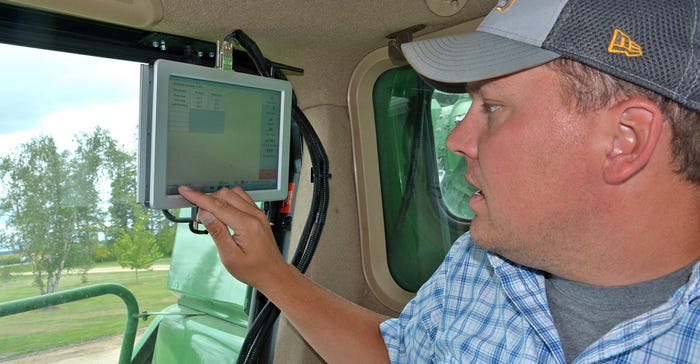
SAMPLE CHECK: Tony Brateng, Roseau, checks his cab monitor while others work on calibrating a CropScan 3000H protein analyzer installed on his combine.
Protein content in wheat and other crops varies across the field depending on fertility, moisture, organic matter, soils. If you could pinpoint those low-protein areas in your field, how would you manage them?
Scientists involved with the Minnesota Wheat On-Farm Research Network and participating growers will soon begin their third growing season with using an on-combine protein analyzer that scans a crop sample about every 100 feet while harvesting. The long-term research goals are to identify factors that influence protein variability within a field and how to manage nitrogen to maximize wheat yield and protein.
In 2017, crop farmer Tony Brateng, Roseau, worked with the network team, his mechanic and a local John Deere technician to install and calibrate a CropScan 3000H on his John Deere 9660 with RTK guidance. After some adjustments, Brateng was successful in gathering protein data on wheat and oil in canola. However, he was unable to collect oil data on corn and soybeans because grain moisture was too high.
Network researcher Rob Proulx said collected data showed some protein patterns in Brateng’s fields, such as higher ground having high protein wheat. However, protein patterns were not consistent across fields.
Last year, the research network group had two protein analyzers available for two farmers involved in the project, Brateng and Kyle Mehrkens, Thief River Falls. These farmers are planning to work again this year with the network team on the project.
After reviewing yield and protein maps as well as data from the previous growing season, research coordinator Melissa Geiszler said they saw what was expected: that protein would be inversely related to yield, and that protein varied with different soil types in the field. Some calibration challenges showed up, too, on one map.
“The machine wasn’t calibrated well enough to read high moisture wheat very well, so it tended to read artificially low proteins when the wheat was wet,” Geiszler said. She is working with the analyzer manufacturer to improve the calibration for this year.
Brateng said he used the analyzer on all his wheat and confirmed that protein was usually lower where yields were good. He noted, too, that in one field, protein ranged from 11.5% to 17%.
While crop characteristics are the end goal, each season everyone learns a bit more about the sensor technology, too. It takes an investment in time to get up to speed on how to install and calibrate the equipment and then collect the data.
“The instrument and the installation are pretty in-depth,” Brateng said. “You can’t pop it off your combine and move it easily.” And if there are questions about the scanner, those are directed to the Australia-based company Next Instruments.
“We harvested about half a day [last year] and the scanner didn’t seem to work,” Brateng said. “It turns out it needed a product update that hadn’t taken place yet. Our days are [Next Instruments’] nights. We contacted them and then they sent it.”
Everyone involved in this project realizes that more research needs to be done. Mehrkens said he appreciates efforts by the on-farm network team and the opportunity to have research done on his farm.
“Wheat Growers is very good in working with farmers and not making it too time consuming,” he said.
Depending on research results and soils, Mehrkens said he may end up tweaking N rates on wheat. For example, on clay versus loam soils, heavier clays typically have lower protein wheat and sandy loams, higher protein wheat. Knowing where those areas are in his fields, Mehrkens can make N adjustments if necessary.
“The more information you have, the better your decisions can be,” Mehrkens said. “Also, if you have applied in-season nitrogen, with the protein analyzer you’ll find out if it pays or not.”
About the Author(s)
You May Also Like






